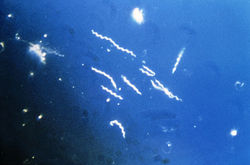Difference between revisions of "Borrelia burgdorferi"
Jump to navigation
Jump to search
| (11 intermediate revisions by 2 users not shown) | |||
| Line 1: | Line 1: | ||
| − | {{ | + | {{review}} |
| − | + | ||
| − | |||
| − | |||
| − | |||
| − | |||
| − | |||
| − | |||
| − | |||
| − | |||
| − | |||
[[File:Borrelia b.jpg|right|thumb|250px|<small><center> ''Borrelia burgdorferi''. (CDC 1993, Wikimedia commons)</center></small>]] | [[File:Borrelia b.jpg|right|thumb|250px|<small><center> ''Borrelia burgdorferi''. (CDC 1993, Wikimedia commons)</center></small>]] | ||
| + | |||
| + | |||
| + | |||
''Borrelia burgdorferi'' is a species of [[Borrelia species - Overview|''Borrelia'' bacteria]]. ''Borrelia'' species are longer, wider, helical [[Spirochaetes species - Overview|spirochaetes]]. | ''Borrelia burgdorferi'' is a species of [[Borrelia species - Overview|''Borrelia'' bacteria]]. ''Borrelia'' species are longer, wider, helical [[Spirochaetes species - Overview|spirochaetes]]. | ||
| − | The ''Borrelia burgdorferi'' sensu lato complex is the cause of '''[[Lyme | + | The ''Borrelia burgdorferi'' sensu lato complex is the cause of '''[[Lyme disease]]'''. |
| + | *''Borrelia burgdorferi'' sensu stricto, the most common cause of canine Lyme disease in the USA. | ||
The bacteria are reported to infect humans, dogs, horses, cattle, sheep. | The bacteria are reported to infect humans, dogs, horses, cattle, sheep. | ||
| Line 19: | Line 14: | ||
Bacteria may be cultured in Barbour-Stoenner-Kelly medium after 6 weeks under microaerophilic conditions. The best samples for culture are skin samples from near to the site of tick attachment (as the bacteria remain within the local connective tissues) but the test is not sensitive as the bacteria will be present in low numbers. | Bacteria may be cultured in Barbour-Stoenner-Kelly medium after 6 weeks under microaerophilic conditions. The best samples for culture are skin samples from near to the site of tick attachment (as the bacteria remain within the local connective tissues) but the test is not sensitive as the bacteria will be present in low numbers. | ||
| − | Ticks are the vector for [[Lyme | + | Ticks are the vector for [[Lyme disease]], in particular, ''[[Ixodes spp.]]''. |
| − | |||
| − | |||
| − | |||
| − | |||
| − | |||
| − | |||
| − | |||
| − | |||
| − | |||
| − | [[Category:Borrelia species]][[Category:Dog | + | [[Category:Borrelia species]][[Category:Dog]][[Category:Horse]][[Category:Cattle]][[Category:Sheep]] |
| − | [[Category: | + | [[Category:Expert_Review]] |
| + | [[Category:To_Do_-_AimeeHicks]] | ||
Revision as of 13:33, 26 July 2010
| This article has been peer reviewed but is awaiting expert review. If you would like to help with this, please see more information about expert reviewing. |
Borrelia burgdorferi is a species of Borrelia bacteria. Borrelia species are longer, wider, helical spirochaetes.
The Borrelia burgdorferi sensu lato complex is the cause of Lyme disease.
- Borrelia burgdorferi sensu stricto, the most common cause of canine Lyme disease in the USA.
The bacteria are reported to infect humans, dogs, horses, cattle, sheep.
Bacteria may be cultured in Barbour-Stoenner-Kelly medium after 6 weeks under microaerophilic conditions. The best samples for culture are skin samples from near to the site of tick attachment (as the bacteria remain within the local connective tissues) but the test is not sensitive as the bacteria will be present in low numbers.
Ticks are the vector for Lyme disease, in particular, Ixodes spp..
